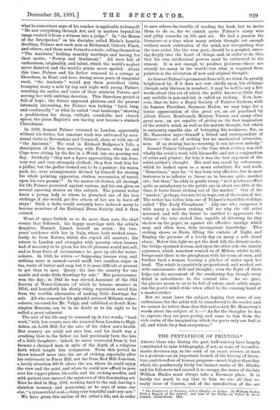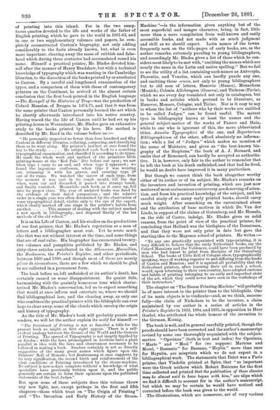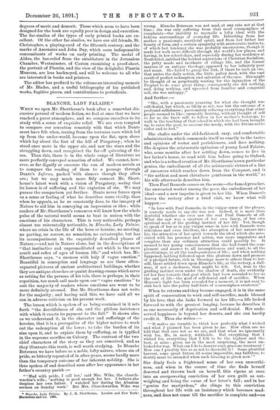THE PENTATEUCH OF PRINTING.*
AMONG those who during the past half-century have largely contributed to raise bibliography, if not, as some of its enthu- siastic devotees say, to the rank of an exact science, at least to a position—as an important branch of the history of litera- ture, and therefore of human progress—much higher than that which the ponderously lively but inexact works of Dr. Dibdin and his followers had caused it to occupy, the name of the late William Blades must always take a foremost place. It is hardly too much to say that to him we owe all that we really know of Caxton, and of the introduction of the art • The Pentateuch of Printing, with a Chapter on Judges. By William Blades. With a Memoir of the Author, and List of his Works, by Talbot B. Rood. Loudon Elliot Stook. 1891.
of printing into this island. For in the two sump- tuous quartos devoted to the life and works of the father of English printing, which he gave to the world in 1861-63, and in one or two supplementary volumes and papers, he com- pletely reconstructed Caxton's biography, not only adding considerably to the facts already known, but, what is even more important, clearing away the mass of rubbish and false- hood which during three centuries bad accumulated round his name. Himself a practical printer, Mr. Blades devoted him- self after the manner of Henry Bradshaw, but with a technical knowledge of typography which was wanting in the Cambridge librarian, to the dissection of the books printed by or attributed to Caxton. By a careful and lengthened examination of the types, and a comparison of them with those of contemporary printers on the Continent, he arrived at the almost certain conclusion that the first book printed in the English language
—The Recu yell of the Histories of Troy—was the production of
Colard Mansion, of Bruges, in 1474-75, and that it was from the same printer that Caxton personally learned the art which he shortly afterwards introduced into his native country.
Having traced the the life of Caxton until he had set up his printing-house in Westminster, Mr. Blades gave an exhaustive study to the books printed by his hero. His method is described by Mr. Reed in the volume before us :—
" He personally inspected no fewer than four hundred and fifty Caxtons in different libraries, collating, comparing, and classifying them as he went along. His printer's instinct at once found the
key to the study He subjected each book to a searching typographical examination, and classified it according to its types. He made the whole work and method of the primitive little printing-house at the 'Bed Pale' live before our eyes ; we saw when type 1 came to an end, and when type 2 appeared ; we found the ingenious craftsman, when type 2 was wearing out, trimming it with his graver, and creating type 2* out of its ruins. We watched the career of each type, from the moment it was cast in its rough mould, till the day when, worn out and discarded, it passed into strange hands, and finally vanished. Meanwhile each book, as it came up, fell into its proper class. The year of undated books was fixed by the evidence of their dated companions ; and the relative order in a single year was often determined by the observation of some typographical detail, visible only to the eye of the expert, which clearly marked off one stage in the printer's habits from another This manner of dealing with the subject marked a new epoch in bibliography, and disposed finally of the lax methods of the old school."
It is on his Life of Caxton, and his studies on the productions of our first printer, that Mr. Blades's reputation as a man of letters and a bibliographer must rest. Yet he wrote much also that was not without interest at the time, and some things that are of real value. His biographer has enumerated twenty-
two volumes and pamphlets published by Mr. Blades, and sixty-three articles contributed to the Athenwum, the Bookworm., the Printer's Register, and other periodicals, between 1860 and 1890, and though most of these are merely pices de circonstance, there are a few which we should be glad to see collected in a permanent form.
The book before us, left unfinished at its author's death, has certainly caused us some disappointment. Its quaint title, harmonising with the quaintly humorous tone which charac- terised Mr. Blades's conversation, led us to expect something that would at once inform and entertain us, where we should find bibliographical lore, and the clearing away, as only one who combines the practical printer with the bibliophile can ever hope to clear away, some of the clouds which envelop the origin and history of typography.
As the title of Mr. Blades's book will probably puzzle most readers, we will let the author explain its motif for himself :— " The Pentateuch of Printing is not so fanciful a title for the present book as might at first sight appear. There is a self- evident analogy between the Genesis of the World and the Genesis of Printing. The spread of Typography is not inaptly typified by an Exodus ; while the laws promulgated in Leviticus have a plain parallel in idea with the laws and observances necessary to be followed in making a book. Numbers certainly is not so directly suggestive of the many great names which figure upon the Printers' Roll of Honour; but Deuteronomy at once suggests, by its very signification, the second birth and reinforcement of the vital conditions of Printing introduced by the steam-machine. No subject is now-a-days complete without a knowledge of what specialists have previously written upon it, and the public generally are certain to form their opinions upon the published statements of the best Judges."
But upon none of these subjects does this volume throw any new light, nor, except perhaps in the first and fifth chapters—those which treat on "The Origin of Printing" and "The Invention and Early History of the Steam- Machine "—is the information given anything but of the most superficial and meagre character, being, in fact, little more than a mere compilation from well-known and easily accessible books, and not made with as much judgment and skill as we should expect. Latin names of the towns. frequently seen on the title-pages of early books, are, as the author remarks, extremely puzzling to young bibliographers, and accordingly Mr. Blades gives a list of those which he con- siders most likely to be met with," omitting the names which are nearly the same in the Latin and native spelling." But we fail to see the utility of a list containing such names as Antverpia, Florentia, and Venetix, which can hardly puzzle any one,
and omitting those cruces, not only to young bibliographers but to old men of letters, Hanovia3 (Hanau), Monachum
(Munich), Colonia Allobrogum (Geneva), and Ticinum (Pavia), which we see every day translated not only in catalogues, but
in books and articles which pretend to be literature, as Hanover, Monaco, Cologne, and Ticino. Nor is it easy to say to whom -the list of "authors who by their works are entitled to be called Judges," can be found useful. The merest tyro in bibliography knows at least the names and the general subject-matter of the works of Panzer and Hain, while to one who is ignorant of this, the mere abbreviated titles, Annales Typographici of the one, and Repertorium Bibliographicum of the other, afford absolutely no informa- tion; while a list of " Judges " which makes no mention of the name of Maittaire, and gives as "the best-known bio-
graphy of the Stephens," the book of A. J. Bernard, and omits that of Renouard, can hardly be accepted as authorita- tive. It is, however, only fair to the author to remember that he left the book at his death unfinished, and that had he lived, he would no doubt have improved it in many particulars.
But though we cannot think the book altogether worthy either of its author or of its subject, Mr. Blades's remarks on the inventors and invention of printing, which are just now matters of most acrimonious controversy, are deserving of atten- tion, and from his practical knowledge of the subject, and his careful study of so many early printed books, should carry much weight. After remarking on the unrestrained abuse and the attribution of base motives in which Dr. Van der Linde, in support of the claims of Gutenberg, and Mr. Hessels, on the side of Coster, indulge, Mr. Blades gives us solid reasons, from the point of view of the practical printer, for concluding that Holland was the birthplace of the Donatuses, and that they were not only prior in date but gave the starting idea to the Mayence school of printers. He writes :— "To any one practically acquainted with type-printing, it is very difficult to believe that the early Netherland books, say the Colard Mansions and the Veldeners, could have been produced by men who had learnt to print from disciples of the Gutenberg School. The books of Ulric Zell of Cologne show, typographically speaking, ways of working superior to and differing from the books of Caxton and Mansion ; and it is against all probability that the Netherland printers, after learning their art in such a school, would, upon returning to their own country, have adopted customs and habits of printing belonging to an early and imperfect state of the art, which they could never have seen in the workshops of their instructors."
The chapter on "The Steam Printing-Machine "will probably be of more interest to the printer than to the bibliophile. One of its main objects is to vindicate—and, as we think, success- fully—the claim of Nicholson to be the inventor, a claim maintained by our author in a series of articles in the
Printer's Register in 1883, 1884, and 1885, in opposition to Herr Goebel, who attributed the whole honour of the invention to
the German, Kcenig.
The book is well, and in general carefully printed, though the proofs should have been corrected and the author's manuscript revised by some one thoroughly acquainted with the subject- matter. " " (both in text and index) for Oporinus, " Marte " and " Moel " for (we suppose) Martens and Morel, " Bassani° " for Bassano, " Heylin " more than once for Heynlin, are misprints which we do not expect in a bibliographical work. The statements that Dolet was a Paris printer, that Vindelin printed at Spire, that "so important
were the Greek authors which Robert Estienne for the first time collected and printed that the publication of these classics may be almost said to have begun with him," are slips which
we find it difficult to account for in the author's manuscript, but which we may be certain he would have noticed and corrected before the book was given to the world.
The illustrations, which are numerous, are of very various degrees of merit and demerit. Those which seem to have been designed for the book are equally poor in design and execution. The fac-similes of the types of early printed books are ex- cellent. Of the other fac-similes, we have our old friends, St. Christopher, a playing-card of the fifteenth century, and the marks of Aseensius and John Day, which seem indispensable concomitants of works on early printing. The medal of Aldus, the bas-relief from the entablature in the Jerusalem Chamber, Westminster, of Caxton examining a proof-sheet, the portrait of Plantin, and the view of the delightful Plantin Museum, are less hackneyed, and will be welcome to all who are interested in books and printers.
The editor has prefixed to the volume an interesting memoir of Mr. Blades, and a useful bibliography of his published works, fugitive pieces, and contributions to periodicals.




































 Previous page
Previous page